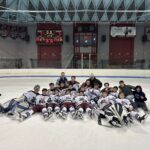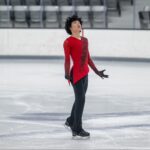The Robotics team, AKA the Jellyfish, have won four different awards at the Utica qualifying robotics competition on January 22 and have qualified for the FIRST regional championship event on March 18.
Members of the Jellyfish after the Utica competition following their
successful qualification for the Regional Championships
The team has been a member of the Tech Challenge competition run by For Inspiration and Recognition of Science and Technologies (FIRST) since the team’s founding in 2010. FIRST is a robotics competition where high school teams build, program, and drive a robot to complete various objectives on a game field.
This year’s FIRST Tech Challenge is known as Power Play. Teams are tasked with building a robot to stack cones on parts of an enclosed stage incorporating junctions, substations, and terminals.
A picture of this year’s robot for the Jellyfish, named “Grace”
after computer scientist Grace Hopper. On a model game
field, the robot is labeled on the side with the team’s FIRST
Tech Challenge number 4654, as they are the 4654th team
to join the organization’s competition.
The Jellyfish robot is controlled by two drivers, one controlling movement, and the other controlling the claw that is used to grab the cones and place them on poles.
During the start of a tournament, an alliance is formed between two teams with each of their robots helping and competing as an alliance. These teams and the rival alliance they face are paired at random for the first five “qualifying rounds” of the tournament. “We can be against upwards of 20 different teams all around New York state,” said Michael Oh, Build President of the team. “In the regional championship, we will be competing with the best teams around New York.”
A model explaining the standard alliance between teams. The blue team in this model work
together and use their two robots to compete against the red team in a game.
In a round, alliances aim to score points by placing cones on the poles throughout a field. At the end of a round, the alliance with the most points wins. Each team will then be paired with a new team member and opposition for the next round. In the finals of a tournament, after five qualifying rounds, the four robotics teams with the most points select two partner teams to form a final alliance which competes against the other three alliances.
“Working on a team is always fun because it’s not just whose team is better,” Relations Officer, Taka Kimura, explained. “Your team could have worse robots than the rival team, but you might have better synergy which allows you to win in pretty cool ways,” Kimura said.
A standard setup to a Power Play game, in which 4 robots, forming 2 alliances between them,
are put on different ends of the field. The robots will then work together to stack cones of
their color on the yellow poles, earning points depending on how high the pole they stacked
the cones on are.
Despite ending with success, the Utica tournament did not always go according to plan. “Utica had a lot of ups and downs,” Jellyfish Programmer Taira Nonami recalled, “the night before the tournament, a key part of our robot cracked.” While a break or crack in a robot can mean failure for many teams, the Jellyfish were prepared for such an incident. “Our team is able to repair any problem that comes our way, so after finding the problem, we grouped together, got what we needed, and repaired our robot before the tournament,” Nonami said.
Out of the 23 teams at the tournament, the Jellyfish placed 18th and were not selected for a final alliance in the last round, seemingly ending their tournament run there. “I think a lot of our issues came from unfortunate scenarios like teammates [alliances] who we didn’t synergize well with,“ President Elliot Zheng said, “but I think the judges were able to see through just the results and look at the strengths of our team like our teamwork and hard work.”
A photo of the Control award won by the Jellyfish at Utica.
Despite the results, the Jellyfish spirit did not wane as they cheered on teams in the finals and prepared for the next events in their season. During the closing ceremony, the Jellyfish won the coveted Inspire award. “I think our spirit is what’s good about our team,” Programmer Matthew Laterza said. “It’s the thing that keeps us optimistic, even when things like placing 18th happen, and I think the judges rewarded us for it.”
At the end of a FIRST tournament, teams are able to qualify for the next stage of the competition in two ways: winning the tournament, or earning specific awards for strengths that their team displays. The Jellyfish advanced to regional championships by winning placements for four of these rewards: Inspire (second place), Control award (first place), Motivate award (second place) and Think award (third place).
| Inspire Award | The most prestigious award of the FIRST Tech Challenge. Given to teams who in the eyes of the judges fully embody the creativity and determination behind the tournament. The top two teams in this award category qualify for regional championships, and the Jellyfish walked home with silver in the category. |
| Control Award | Given to teams who display clear intelligence and creativity when it comes to programming their robot. The programming used for our robot was not only efficient but utilized creative solutions to problems which earned us first in this award category. |
| Motivate Award | Given to teams who truly endorse and spark interest around the main STEM and FIRST ideas in others. Our team has had constant outreach programs, such as Junior Jellies- and afterschool activity in which we present STEM concepts and challenges to 5th graders. This strong bond to inspiring our community allowed us to win second in this award. |
| Think Award | Given to teams who overcome obstacles in their robot through creative engineering. In their overcoming of challenges posed to them during the tournament, the Jellyfish won third place. |
“I was very proud,” Robotics Secretary Fiona Chen said of the experience, “everything worked out for us, even though we had some unfortunate circumstances with the qualifying rounds.” Pride doesn’t always come in winning, however, as Chen was quick to point out. “I wouldn’t necessarily need to qualify [for regionals] to feel like the effort I put in was worth it. I think that just shows in our performance. I was also very, very happy for the freshmen who have never experienced this before. It was their first time and they earned it because they have put a lot into this team.”
“Freshmen are the future of our club,” said Zheng. “Getting them interested and passionate is so important because the next generation needs to be excited to learn. My favorite part this year is how passionate and involved they are. They go to meetings, tournaments, and are invested even outside of the club about Robotics.”
The main logo for the Jellyfish.
“Everything in robotics is so engaging and interesting that it’s given me a sense of belonging in a group,” said freshman Jocelyn Zheng.
“It’s really fulfilling to be integrated so quickly into a team. Everything I’m doing truly feels like it has a purpose,” freshman Amrit Mohapatra said. “It’s even more amazing to go to a tournament and win. It brings meaning and value to the work and preparation we do.”
The full Jellyfish robotics team along with 4th and 5th grade participants of “Junior Jellies”.
This is a community outreach program for the robotics team in which the Jellyfish Introduce concepts of STEM to children within the community through unique challenges
Alex Thompson is a member of the Outreach team for Jellyfish robotics.







